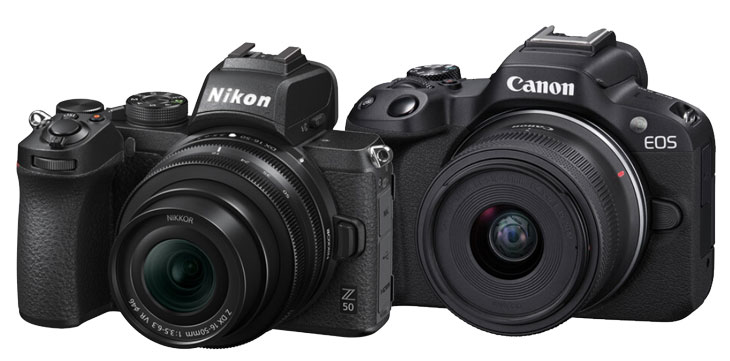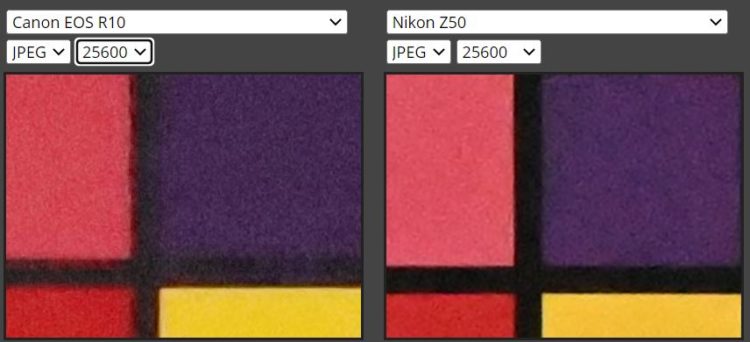
Latest comparison of the design part of the Canon R50 versus the Nikon Z50 camera. Canon R50 features a very ultra-compact body. The big difference between the two is weather sealing. If you shoot mostly outdoors, Z50 and even Z30 feature weather sealing in their body. No weather sealing is present in Canon R50.
Both cameras feature a built-in flash as well as an EVF. They are almost the same. The Canon R50 features a vari-angle display, while the Nikon Z50 features a limited-tilt display screen.
Canon R50 vs Nikon Z50 – Table of contents
Due to the design issue, the Canon R50 camera is more content-creator-friendly when compared to can Nikon Z50
also, see – Canon R10 vs Nikon Z50
Best Lenses for Canon R50 Camera
| Canon R50 | Nikon Z50 | |
| Lens Mount | Canon RF | Nikon Z |
| Sensor Resolution | Effective: 24.2 Megapixel | Actual: 21.51 Megapixel Effective: 20.9 Megapixel (5568 x 3712) |
| Image Sensor | 22.3 x 14.9 mm (APS-C) CMOS | 23.5 x 15.7 mm (APS-C) CMOS |
| Crop Factor | 1.6x | 1.5x |
| Image Stabilization | None | Digital (Video Only) |
| Built-In ND Filter | None | None |
| Capture Type | Stills & Video | Stills & Video |
1. Best Camera for Photography – Canon R50 vs Nikon Z50
Both cameras use an APS-C CMOS sensor. Nikon calls it DX and as you can see, physically the DX sensors are slightly larger compared to the Canon APS-C sensor.
- Nikon’s DX: 23.5 mm x 15.7 mm
- Canon’s APS-C: 22.3 × 14.9 mm
Okay, that doesn’t make too much difference, but since the sensor resolution of Nikon Z50 is 20MP and the sensor size is slightly larger, then due to these two factors automatically the low light performance of the camera upscales compared to others.
If you look at the ISO range chart, then you will see a massive difference between the ISO range of the Canon R50 camera and the Nikon Z50. The maximum ISO range of the Canon R50 camera goes up to ISO 51200 whereas the Nikon Z50’s ISO range is expandable up to 204800.

Since R10 samples are not available at this moment we are picking up, the Canon R10 (both Canon R10 and R50 share the same sensor)
Not only in words and numbers, let’s compare the two practices and try to find out the best camera between these two. As you can see, the ISO range of the Canon camera limits to 25600. Comparing the two, it’s very clear that the Nikon Z50 camera is able to preserve color details in a much better way. As you can see, the color box lines are not melting into each other. Canon R50 is not able to resolve colors at higher ISO ranges.
| Canon R50 | Nikon Z50 | |
| Shutter Type | Electronic Shutter | Electronic Shutter, Mechanical Focal Plane Shutter |
| Shutter Speed | Electronic Shutter 1/8000 Up to 30 Seconds Electronic Front Curtain Shutter 1/4000 Up to 30 Seconds |
Electronic Front Curtain Shutter 1/4000 to 30 Seconds Electronic Shutter 1/4000 to 30 Seconds |
| Bulb/Time Mode | Bulb Mode, Time Mode | Bulb Mode, Time Mode |
| ISO Sensitivity | Photo/Video 100 to 32,000 (Extended: 51,200) |
Photo 100 to 51,200 in Auto Mode (Extended: 100 to 204,800) Video 100 to 25,600 in Manual, Auto Mode |
| Metering Method | Center-Weighted Average, Evaluative, Partial, Spot | Center-Weighted Average, Highlight Weighted, Matrix, Spot |
| Exposure Modes | Aperture Priority, Manual, Program, Shutter Priority | Aperture Priority, Manual, Program, Shutter Priority |
| Exposure Compensation | -3 to +3 EV (1/3 EV Steps) | -5 to +5 EV (1/3, 1/2 EV Steps) |
| Metering Range | -2 to 20 EV | -4 to 17 EV |
| Continuous Shooting | Electronic Shutter Up to 15 fps for up to 28 Frames (JPEG) / 7 Frames (Raw) Electronic Shutter Up to 12 fps for up to 42 Frames (JPEG) / 7 Frames (Raw) |
Up to 11 fps at 20.9 MP Up to 5 fps at 20.9 MP Up to 4 fps at 20.9 MP Up to 30 fps at 8 MP |
2. Autofocus – Canon R50 vs Nikon Z50
Both of them use completely different technology. Canon uses Dual Pixel CMOS autofocus technology and Nikon uses hybrid.
- The Canon R10 DPAF points are fabricated across the entire sensor, with a maximum of 4,503 points (single area mode) or 651 ZONES (when Tracking is enabled).
- The Z50 has 273 points that cover approximately 90% of the sensor. So technically we have less number of AF points inside the Nikon Z50 Mirrorless camera.
| Canon R50 | Nikon Z50 | |
| Focus Type | Auto and Manual Focus | Auto and Manual Focus |
| Focus Mode | Continuous-Servo AF, Manual Focus, Single-Servo AF | Automatic, Continuous-Servo AF, Full-Time Servo, Manual Focus, Single-Servo AF |
| Autofocus Points | Photo Phase Detection: 4503 Video Phase Detection: 3713 |
Phase Detection: 209 |
| Autofocus Sensitivity | -4 to +20 EV | -2 to +19 EV |
If you compare the autofocus points of the two, then you will see a massive difference. Don’t get demoralized after looking at the fewer number of points in Nikon Z50 camera. It is also highly usable and a perfect companion for general-purpose photography. You can also shoot sports and wildlife with this but don’t expect Hi-Fi 3D AF tracking performance from this camera.
If you are more into sports and wildlife photography and love to have a perfect camera under budget, then I highly recommend you to get the Canon R50 camera if possible, which has the fastest burst speed of 23 frames per second.
3. Best Camera – AF sensitivity – Canon R50 vs Nikon Z50
The stats say, the Canon R50 has a minimum sensitivity in the low light of -4EV, which is excellent for a class of camera like the Canon R10. The AF sensitivity of measured with an F1.2 lens is practically impossible to buy for beginners. So, it’s eq to – 2.5EV with an F2 lens.
Z50 has a rating of -2EV, or -4EV if you activate the Low Light AF mode (which is slower but can help in very dim light conditions). This data is measured with an F2 lens.
The R50 has a few extra features concerning autofocus, like focus bracketing and focus stacking which will interest macro photographers. So technically if he takes all the aspects here in terms of autofocusing performance of the two cameras then Canon R50 is a clear winner.
4. Best Camera for Sports and Wildlife – Canon R50 vs Nikon Z50
The Canon R50 camera doesn’t have any fully mechanical shutter, neither does the Nikon Z50. The Nikon Z50 specification says it has a mechanical focal plane shutter, but once we enter into the specs of the camera, we are able to witness only two shutters and these are:
Not able to see mention of any fully mechanical shutter. In the same way, even Canon R50 camera doesn’t have a fully mechanical shutter.
Now Canon is able to utilize its electronic shutter even when you are using the burst speed of the camera, but in Nikon Z50 we are limited to the use of only a mechanical shutter in high-speed burst mode. Since the camera doesn’t have a stacked CMOS sensor, there is literally no use in boosting up your shutter speed on electronic shutter steroids. You will have a massive rolling shutter effect in your images.
We highly recommend you go with Nikon Z50 for sports and wildlife photography. If you can spend more, then only Canon R10.
| Canon R50 | Nikon Z50 | |
| Internal Recording Modes | H.264/H.265/MPEG-4 UHD 4K (3840 x 2160) at 23.98/25/29.97 fps 1920 x 1080 at 23.98/25/29.97/50/59.94/100/120 fps |
H.264/MOV/MP4 UHD 4K (3840 x 2160) at 23.98/25/29.97 fps 1920 x 1080p at 23.98/25/29.97/50/59.94/100 fps |
| Broadcast Output | NTSC/PAL | NTSC/PAL |
| Recording Limit | Stereo | Stereo |
5. Best Camera for Video – Canon R50 vs Nikon Z50
Both can record 4K videos up to 30 frames per second. Due to the use of a low light sensitive sensor in Nikon Z50, you are able to capture uncontrolled light videos in a better way. Even at higher ISO, Nikon Z50 camera is able to preserve more details, as we have already seen in the ISO test.
The Canon R50 has an amazing ability to record 10-bit HDR PQ videos. But at the same time, you need additional lights to get the maximum out from the R50 sensor. Otherwise, in an uncontrolled light environment, the quality goes even below that of Nikon Z50’s 8-bit output.
So if you are working in an uncontrolled light environment where you do not have any access to dedicated lights, you should buy the Nikon Z50. Otherwise, if you’re working with lights and in your studio, then Canon R50 is a better choice.
6. Content creators and bloggers
The best camera for you is Canon R50 due to its flexible vari-angle display screen. Nikon Z50’s screen rotates in a 180-degree fashion which is not that much usable. It’s better to buy Canon R50.
| Canon R50 | Nikon Z50 | |
| Battery Type | 1 x LP-E17 Rechargeable Lithium Polymer, 7.2 VDC, 1040 mAh | 1 x EN-EL25 Rechargeable Lithium-Ion, 7.6 VDC, 1120 mAh (Approx. 300 Shots) |
| Tripod Mounting Thread | 1 x 1/4″-20 Female (Bottom) | 1 x 1/4″-20 Female (Bottom) |
| Dimensions (W x H x D) | 4.6 x 3.4 x 2.7″ / 116.3 x 85.5 x 68.8 mm | 4.98 x 3.68 x 2.36″ / 126.5 x 93.5 x 60 mm |
| Weight | 13.2 oz / 375 g (With Battery, Recording Media) 11.6 oz / 328 g (Body Only) |
13.93 oz / 395 g (Body Only)
|
Help us to get a Barista Coffe
Latest Price of Nikon Z50 B&H | Amazon.com
Get Canon R50 From Amazon.com | B&H Store







